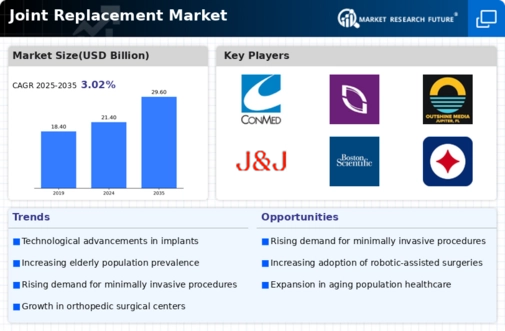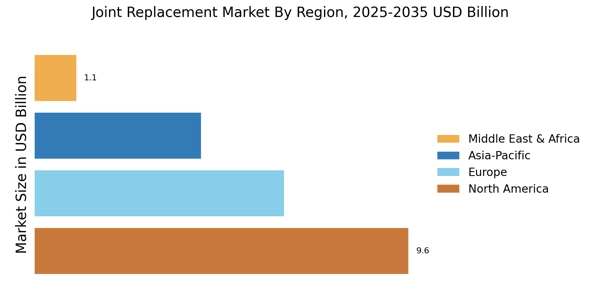Increased Healthcare Expenditure
Increased healthcare expenditure is a critical driver of the Joint Replacement Market. As countries invest more in healthcare infrastructure and services, access to joint replacement surgeries improves. This trend is particularly evident in developed nations, where healthcare spending has risen significantly over the past decade. For example, the United States spends over 17% of its GDP on healthcare, facilitating advancements in medical technologies and surgical procedures. This financial commitment enables hospitals and clinics to offer state-of-the-art joint replacement options, attracting more patients. Additionally, as insurance coverage expands and more individuals gain access to healthcare, the demand for joint replacements is likely to increase. Consequently, the Joint Replacement Market stands to benefit from this upward trend in healthcare investment, which supports both innovation and patient access.
Growing Awareness of Joint Health
Growing awareness of joint health is influencing the Joint Replacement Market positively. Educational campaigns and initiatives aimed at promoting joint health and mobility are becoming more prevalent. As individuals become more informed about the risks associated with joint degeneration and the benefits of timely intervention, they are more likely to seek medical advice and consider joint replacement options. This heightened awareness is particularly important among aging populations, who may experience joint-related issues. Furthermore, the rise of social media and online health resources has facilitated the dissemination of information, empowering patients to make informed decisions regarding their joint health. As awareness continues to grow, the Joint Replacement Market is expected to experience increased demand for surgical interventions, as more individuals recognize the importance of maintaining joint function and quality of life.
Rising Prevalence of Osteoarthritis
The increasing prevalence of osteoarthritis is a notable driver in the Joint Replacement Market. As populations age, the incidence of osteoarthritis rises, leading to a greater demand for joint replacement surgeries. According to recent data, approximately 27 million adults in the United States are affected by osteoarthritis, which significantly impacts mobility and quality of life. This condition often necessitates surgical intervention, thereby propelling the growth of the joint replacement sector. The Joint Replacement Market is likely to see a surge in demand for knee and hip replacements, as these joints are most commonly affected by osteoarthritis. Furthermore, the rising awareness of treatment options and advancements in surgical techniques may encourage more patients to seek joint replacement solutions, further driving market expansion.
Shift Towards Personalized Medicine
The shift towards personalized medicine is emerging as a significant driver in the Joint Replacement Market. Tailoring treatment plans to individual patient needs enhances the effectiveness of joint replacement surgeries. Advances in biomaterials and implant technologies allow for customized solutions that cater to specific anatomical and physiological requirements. This trend is particularly relevant in joint replacement, where factors such as age, activity level, and overall health can influence surgical outcomes. The market is likely to see an increase in demand for personalized implants and surgical approaches, as patients seek solutions that align with their unique circumstances. As research continues to evolve in this area, the Joint Replacement Market may witness a transformation in how joint replacements are approached, leading to improved patient satisfaction and long-term success rates.
Technological Innovations in Surgical Techniques
Technological innovations in surgical techniques are transforming the Joint Replacement Market. Minimally invasive procedures, robotic-assisted surgeries, and enhanced imaging technologies are becoming increasingly prevalent. These advancements not only improve surgical outcomes but also reduce recovery times, making joint replacement surgeries more appealing to patients. For instance, robotic-assisted surgeries have been shown to enhance precision and reduce complications, which may lead to higher patient satisfaction rates. The market is projected to grow as these technologies become more widely adopted, with estimates suggesting a compound annual growth rate of over 6% in the coming years. As healthcare providers continue to invest in cutting-edge technologies, the Joint Replacement Market is poised for significant growth, driven by improved patient outcomes and operational efficiencies.


















Leave a Comment